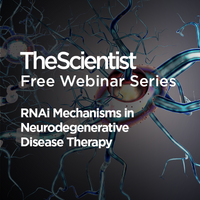Login
Subscribeneurology

Brain Fog Caused by Long COVID and Chemo Appear Similar
Dan Robitzski | Jan 28, 2022 | 6 min read
Data from mouse models for mild coronavirus infections and human tissue samples offer further evidence that it doesn’t take a severe infection—or even infection of brain cells at all—to cause long-term neurological symptoms.

Study Links Flu to Increased Parkinson’s Risk a Decade Later
Dan Robitzski | Nov 19, 2021 | 5 min read
Epidemiological research suggests that a flu diagnosis might be one factor in the eventual onset of the neurodegenerative disease, but experts say it doesn’t prove a causal relationship.

Mapping Neuronal Gene Expression to Understand Pain
The Scientist Creative Services Team in collaboration with Advanced Cell Diagnostics | 1 min read
Ted Price, Diana Tavares-Ferreira, and Stephanie Shiers discuss how mapping gene expression at the neuronal level provides insight into pain mechanisms and anti-pain drug development.

Celebrated Neuropsychologist Muriel Lezak Dies at 94
Lisa Winter | Nov 8, 2021 | 2 min read
She wrote the book on brain injuries.

Citing Safety, French Institutions Temporarily Halt Prion Research
Annie Melchor | Jul 28, 2021 | 3 min read
The three-month moratorium comes after a former prion researcher was diagnosed with Creutzfeldt-Jakob disease.

Gaining Biological Insights into Brain Development Using Single Cell Technologies
The Scientist Creative Services Team in collaboration with 10x Genomics | 1 min read
Richard Smith will discuss the importance of ionic flux in in utero neuronal development.

Seizures Common in Hospitalized COVID-19 Patients
Emma Yasinski | Apr 12, 2021 | 4 min read
The death rate was higher among those who experienced the seizures, according to a study conducted during the early days of the pandemic.

Mary Jeanne Kreek, Methadone Developer, Dies at 84
Asher Jones | Mar 31, 2021 | 2 min read
A physician and neurobiologist at the Rockefeller University who specialized in addiction research, Kreek was best known for her work on developing the treatment for heroin addiction.

The Brain on COVID-19
The Scientist | 1 min read
Connecting the dots between COVID-19 and neurological disorders

Brain Stimulation Tested to Awaken Coma Patients
Shawna Williams | Feb 5, 2021 | 4 min read
Two out of three people who received noninvasive ultrasound appear to have gained some level of consciousness, according to preliminary trial results.

COVID-19’s Effects on the Brain
Katarina Zimmer | Jan 20, 2021 | 9 min read
Autopsy studies have yet to find clear evidence of destructive viral invasion into patients’ brains, pushing researchers to consider alternative explanations of how SARS-CoV-2 causes neurological symptoms.

Beyond Acute Respiration: SARS-CoV-2's Effects on Long-Term Physiology
The Scientist | 1 min read
John Connolly and Masataka Nishiga discuss the effects of SARS-CoV-2 on the neurological and cardiovascular systems.

Mystery Illness Cluster in India May Be Due to Neurotoxin
Lisa Winter | Dec 9, 2020 | 2 min read
Health officials are searching for possible exposures to heavy metals, but no sources of contamination have been identified.

Non-Concussive Head Hits Influence the Brain’s Microstructure
Lisa Winter | Oct 1, 2020 | 2 min read
Comparing the brain scans of high-impact rugby players with those of athletes in noncontact sports, such as rowing and swimming, revealed tiny, yet significant, differences in the brain’s white matter.

Breaking Down Barriers
The Scientist | 1 min read
Looking at the future of neurodegeneration research!

Newly Found Alzheimer’s Plaque Type Linked to Early-Onset Disease
Ian Le Guillou | Sep 28, 2020 | 4 min read
These “coarse-grained” plaques resemble those that clog up the brain’s blood vessels in a different disease, pointing to links between the vascular system and the neurodegenerative disease.

Blood Replacement Rescues Mice from Stroke Damage
Amanda Heidt | Aug 31, 2020 | 5 min read
When mice that had suffered a stroke were given blood from a healthy donor, they experienced less tissue and neurological damage.

RNAi Mechanisms in Neurodegenerative Disease Therapy
The Scientist | 1 min read
Experts will explore how RNAi mechanisms can modulate gene expression for the treatment of neurodegenerative diseases and how new methods for their use are being developed.

Flu and Pneumonia Vaccines Linked to Reduced Risk of Alzheimer’s
Amanda Heidt | Jul 27, 2020 | 3 min read
The authors propose that the shots might keep the immune system primed to battle diseases that would otherwise contribute to cognitive decline.
